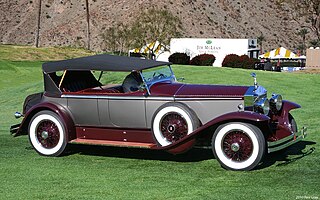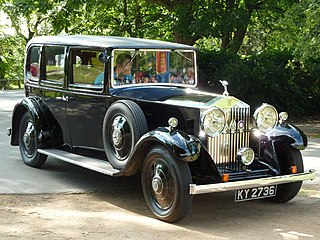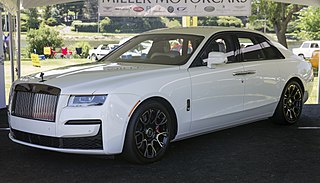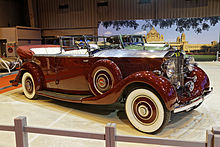
The Rolls-Royce Silver Cloud is a luxury automobile produced by Rolls-Royce Limited from April 1955 to March 1966. It was the core model of the Rolls-Royce range during that period. The Silver Cloud replaced the Silver Dawn and was, in turn, replaced by the Silver Shadow. The John P. Blatchley design was a major change from the pre-war models and the highly derivative Silver Dawn. As part of a range rationalisation, the Bentley S1 was made essentially identical, apart from its radiator grille and badging.

The Morgan 4/4 is a British motor car which was produced by the Morgan Motor Company from 1936 to 2018. It was Morgan's first car with four wheels, the name indicating that the model has four wheels and four cylinders. Early publicity and advertising material variously referred to the model as "4/4", "4-4", "Four Four", and similar names, but from the outset the factory designation was always "4/4".

The Rolls-Royce Silver Dawn is a full-size luxury car that was produced by Rolls-Royce at their Crewe works between 1949 and 1955. It was the first Rolls-Royce car to be offered with a factory built body which it shared, along with its chassis, with the Bentley Mark VI until 1952 and then the Bentley R Type until production finished in 1955. The car was first introduced as an export only model. The left hand drive manual transmission models had a column gear change, while right hand drives had a floor change by the door. In the British home market the Silver Dawn only became available from October 1953, with the introduction of the model corresponding to the Bentley R Type.

The Rolls-Royce Silver Ghost name refers both to a car model and one specific car from that series. Originally named the "40/50 h.p." the chassis was first made at Royce's Manchester works, with production moving to Derby in July 1908, and also, between 1921 and 1926, in Springfield, Massachusetts, USA. Chassis no. 60551, registered AX 201, was the car that was originally given the name "Silver Ghost". Other 40/50 hp cars were also given names, but the Silver Ghost title was taken up by the press, and soon all 40/50s were called by the name, a fact not officially recognised by Rolls-Royce until 1925, when the Phantom range was launched.

The Bentley Mark VI is an automobile from Bentley which was produced from 1946 until 1952.

The Bentley R Type is the second series of post-war Bentley automobiles, replacing the Mark VI. Essentially a larger-boot version of the Mk VI, the R type is regarded by some as a stop-gap before the introduction of the S series cars in 1955. As with its predecessor, a standard body was available as well as coachbuilt versions by firms including H. J. Mulliner & Co., Park Ward, Harold Radford, Freestone and Webb, Carrosserie Worblaufen and others.

The Silver Wraith was the first post-war Rolls-Royce. It was made from 1946 to 1958 as only a chassis at the company's Crewe factory, its former Merlin engine plant, alongside the shorter Bentley Mark VI. The Bentley was also available as a chassis for coachbuilders, but for the first time could be bought with a Rolls-Royce built Standard Steel body. The use of the name "wraith" coincided with the established tradition of naming models after "ghosts".

The Rolls-Royce Phantom was Rolls-Royce's replacement for the original Silver Ghost. Introduced as the New Phantom in 1925, the Phantom had a larger engine than the Silver Ghost and used pushrod-operated overhead valves instead of the Silver Ghost's side valves.

The Rolls-Royce Phantom II was the third and last of Rolls-Royce's 40/50 hp models, replacing the New Phantom in 1929. It used an improved version of the New Phantom engine in an all-new chassis. A "Continental" version, with a short wheelbase and stiffer springs, was offered.

The Bentley 3½ Litre was presented to the public in September 1933, shortly after the death of Henry Royce, and was the first new Bentley model following Rolls-Royce's acquisition of the Bentley brand in 1931.

The Bentley Mark V was Rolls-Royce's second Bentley model. Intended for announcement at the Earl's Court Motor Show set down for late October 1939 it had much in common with its predecessor. War was declared on 3 September 1939 and a few days later Bentley announced it had ceased production of civilian items.

The Rolls-Royce Wraith was built by Rolls-Royce at their Derby factory from 1938 to 1939 and supplied to independent coachbuilders as a rolling chassis.

The Rolls-Royce 20/25 was the second of Rolls-Royce Ltd's pre-war entry level models. Built between 1929 and 1936, it was tremendously popular, becoming the most successful selling inter-war Rolls-Royce. Its success enabled Rolls-Royce to survive the economic difficulties of the Great Depression years and remain one of world's great brands. A total of 3,827 20/25s were produced, of which over 70% are still on the road today.

The Riley Nine was one of the most successful light sporting cars produced by the British motor industry in the inter war period. It was made by the Riley company of Coventry, England with a wide range of body styles between 1926 and 1938.

The Rolls-Royce Twenty built between 1922 and 1929 was Rolls-Royce's "small car" for the 1920s and was produced alongside the 40/50 Silver Ghost and the successor to the 40/50, the Phantom. It was intended to appeal to owner-drivers but many were sold to customers with chauffeurs.

The Rolls-Royce 25/30 built between 1936 and 1938 is an updated version of the 20/25 with larger engine to provide more power, as over-large bodies had often been fitted to the earlier model leading to complaints about its performance.
The Rolls-Royce 20 hp was one of four car models to be produced as a result of an agreement of 23 December 1904 between Charles Rolls and Henry Royce. Badged as a Rolls-Royce, the 20 hp was produced during 1905 and 1906 by Royce's company, Royce Ltd. at its factory in Cooke Street, Hulme, Manchester. It was sold exclusively by Rolls' motor dealership, C.S.Rolls & Co., at a price of GBP650. The 20 hp was exhibited at the Paris Salon in December 1904, along with the 10 hp, 15 hp and engine for the 30 hp models.

The Rolls-Royce Ghost is a full-sized luxury car manufactured by Rolls-Royce Motor Cars. The "Ghost" nameplate, named in honour of the Silver Ghost, a car first produced in 1906, was announced in April 2009 at the Auto Shanghai show. The production model was officially unveiled at the 2009 Frankfurt Motor Show. The Ghost Extended Wheelbase was introduced in 2011. During development, the Ghost was known as the "RR04". It was designed as a smaller, "more measured, more realistic car" than the Phantom, aiming for a lower price category for Rolls-Royce models.

The Lanchester Eighteen at first known as the 15/18 was announced at the beginning of October 1931. Quite unlike any previous Lanchester it was their first new car following BSA's takeover of The Lanchester Motor Company Limited in January 1931. A medium sized car was a new departure for Lanchester.




















